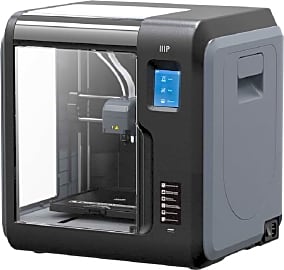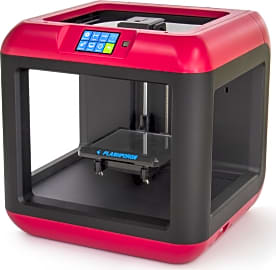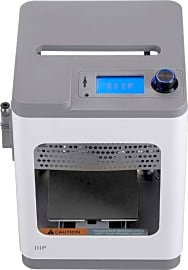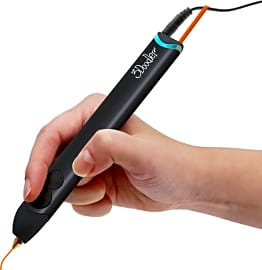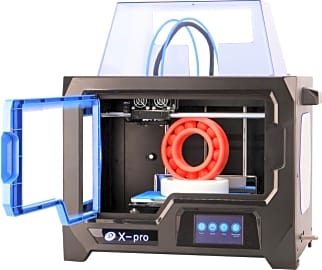The 7 Best 3D Printers For Kids

This wiki has been updated 32 times since it was first published in November of 2016. Remember when we were kids and the idea of using futuristic technology to build and create cool stuff at the touch of a button was pure science fiction? Well, it's no mere fantasy anymore: these 3D printers can do just that, giving children (and adults, if we're being completely honest) the means to design and construct practically anything they can dream up, so long as it'll fit on the platform. When users buy our independently chosen editorial recommendations, we may earn commissions to help fund the Wiki.
Editor's Notes
April 02, 2021:
After checking in on some long-term reviews, we decided to remove the Labists Mini due to inconsistencies and unreliable hardware. Also, the Qidi X-Smart is now pretty tough to get your hands on, but we definitely still recommend the Qidi Technology X-Maker, which has retained the top spot on our list. It's one of the top choices for teens who are really into technology.
We did add the Monoprice Cadet with this round of updates. Monoprice is an interesting company that gets very little press, but is actually pretty well-respected in the electronics department. This particular release of theirs isn't exactly a high-end model, as its moderate price should tell you, but for beginners, it's hard to beat.
February 27, 2020:
There are a few safety concerns when it comes to using 3D printers around kids. First of all, you should avoid letting the young ones use resin printers, as the fumes are especially noxious. For that matter, even when using fused deposition modeling, it's a good idea to make sure there's proper ventilation. Even though the end products tend to be nearly or completely non-toxic, the fumes that result from their heating may not be. ABS, for example, is what Legos are made from, but when heated it produces dangerous volatile organic compounds. Also, you might want to consider an enclosed model, particularly if there are especially young kids around or if you'll be using it around a group of youngsters -- for example, in school. Aside from making high-temperature filaments work better, it keeps people and the models safe. For that reason, all of our freestanding models aside from the Labists Mini are fully enclosed. And above all, make sure to always provide adult supervision when children are working with any industrial tool, no matter how innocuous it may seem; they all get very hot and use potentially hazardous chemicals.
Once you're certain you're safe, you can select the right model for you. The Qidi Technology X-Maker is a mid-range unit that would even satisfy many adults, while the Qidi Technology X-Smart is a bit less expensive and drops just a few features such as the integrated camera. The Flashforge Finder is specifically designed for educational use, so it is easy to use, although its unheated build plate is less than ideal. Possibly even easier to use out of the box is the Monoprice Voxel, which even surprises some experienced professionals with how well-calibrated it is right out of the box. At the clear other end of the spectrum is the Qidi X-Pro. It is not in any way a basic 3D printer, but for those who already know a bit about what they're doing, it's a great next step.
We've also included a couple 3D pens. There are decidedly few of these types of devices worth purchasing, but the 3Doodler Create+ is definitely one of them. It's relatively straightforward to use and, as such, is good for young kids who want to draw in three dimensions. The Mynt3D Pen, on the other hand, has a bit of a learning curve, but in skilled hands it can be an excellent addition to an artist's toolbox.
Why All Kids Should Own A 3D Printer
On the one hand, it deeply involves the use or creation of 3D models, all of which are rendered on digital platforms.
With each passing generation, it seems that children have more and more options for their entertainment. Nowadays, many of those entertainment media are exclusively digital, meaning that their experience starts and ends on a screen. There’s no reason to believe that this is problematic for our children’s education and preparedness for their adult lives, however, as we’ll likely be spending increasing amounts of time tied into digital platforms as the years go by.
But there’s still a physical world out there that we have to navigate, and in which we must physically exist. And to that end, experience with 3D printing may give your kid a leg up in a society that’s become obsessed with virtual worlds.
On an individual level, using a 3D printer gives your child a two-fold positive experience. On the one hand, it deeply involves the use or creation of 3D models, all of which are rendered on digital platforms. If your kid can effectively play any modern video game, he or she can also tackle the preparations needed to create a 3D-printed model. On the other hand, those models, once printed, exist in the real world, and by their very existence they pull your child out of the digital world and back to our immediate reality. So, despite the fact that 3D printers rely on digital media to create their designs, you might actually see your child spending less time in front of a screen thanks to them.
More practically perhaps is that 3D printers are becoming increasingly important to a large number of industries. Everything from big automotive companies to little startups use 3D printing to create prototypes, and in some cases even final products. If your child can enter the workforce with years of 3D printing experience under their belt, the odds of them landing a well-paying job are much higher.
Even if you disregard the potential short and long term benefits of your kid using a 3D printer, there’s another reason they should have one. It’s fun. When I was a kid, we used LEGOs to cobble together structures from the depths of our imaginations. Today, kids can have that gratifying experience with surprisingly inexpensive technologies that are a blast to use.
How To Choose The Best 3D Printer For Your Kid
As you examine the 3D printers on the market, you shouldn’t feel too badly if many of them seem like variations on a theme. Many models look the same, and some even have similar sounding names. We’ve broken down the vast quantity of options to a set that’s sure to please, but even among them it can be hard to see why one is better than another, or what will be quite right for your child.
Either way, make sure you have a long talk with them about safe use, and don’t let them use their printer without your supervision.
So, let’s endeavor to break our list down even further, so you can make a decision with confidence. To begin, you may have noticed that 3D printers generally fall into one of two categories: mechanical and pen-based. Mechanical 3D printers take designs rendered on the computer and translate them to a physical object. The machines function in ways very similar to inkjet printers, but instead of ink their material is a molten form of plastic, and instead of printing flat against a sheet of paper, 3D printers layer that plastic upward from a base until a three dimensional shape is created.
Pen-style printers work almost like hot glue guns. These devices fit in the hand much like a writing or drawing implement, and they gradually push out the same molten plastic used by mechanical 3D printers. The big difference here is that the templates are sent to a machine to be interpreted; they’re interpreted directly by the child. This style also allows for free-form creations of abstract shapes.
For industrial applications, knowing the ins and outs of the mechanical type is undoubtedly more important, but if your child has a more impressionistic artistic bent, then the pen style printers might be more their speed.
As a safety note, this molten plastic comes out very hot and cools to a hardened state almost instantly, which means it can be rather dangerous. Some of the mechanical options on the market have doors built into them that have to be shut in order for the units to run. Others are open-air models. These and the pen-based models are undoubtedly the most dangerous options out there, so if you think your kid might be tempted to touch the gooey plastic, it’d be smart to look for a model with a door. Either way, make sure you have a long talk with them about safe use, and don’t let them use their printer without your supervision.
A Brief History Of 3D Printing
While it certainly seems like a new technology, 3D printing reaches back a little farther than you might think. In fact, the first example of a 3D printer was the rapid prototyping system created by Japanese industrial researcher Hideo Kodama in 1981. Just a few years later, a man named Charles Hull created what he called a stereolithography machine, which used lasers to blast-harden UV-sensitive liquid photopolymers.
In fact, the first example of a 3D printer was the rapid prototyping system created by Japanese industrial researcher Hideo Kodama in 1981.
In the late 1990s, researchers began successfully experimenting with 3D printing as a means of generating human tissue. Everything from the scaffolds of a bladder to bioprinted blood vessels were successfully implanted in patients over the next decade, and other industries began to tinker with the technology in their research and development shops.
In recent years, the cost of both 3D printers and the act of 3D printing has plummeted. Combined with an abundance of open-source printing software and hardware schematics, the technology has become ubiquitous on the industrial landscape, and has even led to the realization of products that otherwise may never have seen the light of day.
Some folks might argue that creating a machine that’s essentially capable of creating more machines of its own kind is a key ingredient to the inevitable robotic revolution, in which we puny humans are rendered slaves to their superior artificial intelligence and stainless steel strength. If those people are right, then it’s even more important that your kid knows how to use (and maybe how to destroy) a good 3D Printer.


